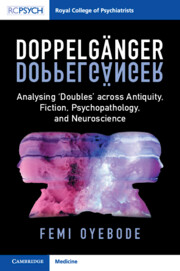Book contents
- Doppelgänger
- Reviews
- Doppelgänger
- Copyright page
- Dedication
- Contents
- Chapter 1 Introduction
- Chapter 2 The Double in Antiquity
- Chapter 3 The Double as Other in the Novel
- Chapter 4 The Double as Duality in Fiction
- Chapter 5 Implicit Double in Fiction
- Chapter 6 The Double in Film
- Chapter 7 The Double in Clinical Psychopathology
- Chapter 8 The Double in Neuroscience
- Chapter 9 The Ultimate Illusion
- References
- Index
Chapter 3 - The Double as Other in the Novel
Published online by Cambridge University Press: 13 March 2025
- Doppelgänger
- Reviews
- Doppelgänger
- Copyright page
- Dedication
- Contents
- Chapter 1 Introduction
- Chapter 2 The Double in Antiquity
- Chapter 3 The Double as Other in the Novel
- Chapter 4 The Double as Duality in Fiction
- Chapter 5 Implicit Double in Fiction
- Chapter 6 The Double in Film
- Chapter 7 The Double in Clinical Psychopathology
- Chapter 8 The Double in Neuroscience
- Chapter 9 The Ultimate Illusion
- References
- Index
Summary
James Hogg’s The Private Memoirs and Confessions of a Justified Sinner sets the scene for the modern expression of the notion of the double in fiction. E. T. A. Hoffman’s novel The Devil’s Elixir covers a similar territory. In this chapter, these two novels provide the backdrop for an exploration of Dostoyevsky’s The Double. This is perhaps the most popular novel that deals with the concept of the double. I argue that the accuracy of the subjective experience of the double suggests that the authors probably had personal experience in autoscopy. This is particularly true of Guy de Maupassant in his novella The Horla. In these novels, the double has a physical existence independent of the originating self. This is true too for the novels by José Saramago and Shusaku Endo that deal with this subject.
Keywords
- Type
- Chapter
- Information
- DoppelgängerAnalysing ‘Doubles' across Antiquity, Fiction, Psychopathology, and Neuroscience, pp. 33 - 77Publisher: Cambridge University PressPrint publication year: 2025

